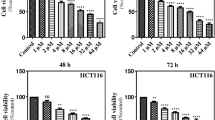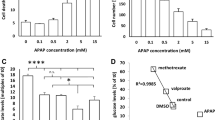Abstract
The mechanism of cytotoxicity on liver carcinoma Bel-7402 cells induced by copper-1,10-phenanthroline, Cu(OP)2, has been studied. Cell viability and apoptotic rate were examined in cells treated with Cu(OP)2 or Cu2+ alone. It was found that the apoptosis induced by Cu(OP)2 could not be induced by Cu2+ or OP alone in our experimental conditions. Total copper content in cells was measured by atomic absorption spectrophotometry, and the abnormal elevation of intracellular copper transported by lipophilic OP ligand may play the role of initial factor in the apoptosis, which caused subsequent redox state changes in cells. Intracellular levels of reactive oxygen species (ROS) were detected by fluorescent probe 2′,7′-dichlorofluorescein diacetate (DCFH-DA). Reduced (GSH) and total glutathione (GSSG + GSH) were determined by High-performance liquid chromatography (HPLC) after derivatization, and the ratios of GSH/GSSG were subsequently calculated. The overproduction of ROS and the decreased GSH/GSSG ratio were observed in cells which represented the occurrence of oxidative stress in the apoptosis. Oxidative DNA damage was also found in cells treated with Cu(OP)2 in the early stage of the apoptosis, and it suggests that the activation of DNA repair system may be involved in the pathway of the apoptosis induced by Cu(OP)2.
Similar content being viewed by others
References
Barbara SB, Stadtman ER (1997) Protein oxidation in aging, disease, and oxidative stress. J Biol Chem 272:20313–20316
Bradford S (1976) Protein determination. Anal Biochem 72:248–252
Burkitt MJ, Milne L, Nicotera P, Orrenius S (1996) 1,10-Phenanthroline stimulates internucleosomal DNA fragmentation in isolated rat-liver nuclei by promoting the redox activity of endogenous copper ions. Biochem J 313:163–170
Buttke TM, Sandstrom PA (1994) Oxidative stress as a mediator of apoptosis. Immunol Today 15:7–10
Cereser C, Guichard J, Drai J (2001) Quantitation of reduced and total glutathione at the femtomole level by high-performance liquid chromatography with fluorescence detection: application to red blood cells and cultured fibroblasts. J Chromatogr B 752:123–132
Chen F, Shi X (2002) Intracellular signal transduction of cells in response to carcinogenic metals. Crit Rev Oncol Hematol 42:105–121
Collins AR (2004) The comet assay for DNA damage and repair. Mol Biotechnol 26:249–261
Cotgreave IA, Gerdes RG (1998) Recent trends in glutathione biochemistry—glutathione–protein interactions: a molecular link between oxidative stress and cell proliferation? Biochem Biophys Res Commun 242:1–9
Curtin JF, Donovan M, Cotter TG (2002) Regulation and measurement of oxidative stress in apoptosis. J Immunol Methods 265:49–72
Danks DM (1988) Copper deficiency in humans. Annu Rev Nutr 8:235–257
Dean RT, Fu S, Stocker R, Davies MJ (1997) Biochemistry and pathology of radical-mediated protein oxidation. Biochem J 324:1–18
Dizdaroglu M, Aruoma OI, Halliwell B (1990) Modification of bases in DNA by copper ion-1,10-phenanthroline complexes. Biochemistry 29:8447–8451
Gaetke LM, Chow CK (2003) Copper toxicity, oxidative stress, and antioxidant nutrients. Toxicology 189:147–163
Galaris D, Evangelou A (2002) The role of oxidative stress in mechanisms of metal-induced carcinogenesis. Crit Rev Oncol Hematol 42:93–103
Gerschenson LE, Rotello RL (1992) Apoptosis: A different type of cell death. FASEB J 6:2450–2455
Halliwell B, Aruoma OI (1991) DNA damage by oxygen-derived species. Its mechanism and measurement in mammalian system. FEBS Lett 281:9–19
Jabs T (1999) Reactive oxygen intermediates as mediators of programmed cell death in plants and animals. Biochem Pharmacol 57:231–245
Klatt P, Lamas S (2000) Regulation of protein function by S-glutathiolation in response to oxidative and nitrosative stress. Eur J Biochem 267:4928–4944
Krzysztof K, Anna L, Anna B, et al. (2003) A cross-platform public domain PC image-analysis program for the comet assay. Mut Res 534:15–20
Linder MC (2001) Copper and genomic stability in mammals. Mut Res 475:141–152
Ma Y, Cao L, Kawabata T, Yoshino T, Yang BB, Okada S (1998) Cupric nitrilotriacetate induces oxidative DNA damage and apoptosis in human leukemia HL-60 cells. Free Radic Biol Med 25:568–575
Mosmann T (1983) Rapid colorimetric assay for cellular growth and survival: application to proliferation and cytotoxicity assays. J Immunol Methods 65:55–63
Norbury CJ, Zhivotovsky B (2004) DNA damage-induced apoptosis. Oncogene 23:2797–2808
Pourahmad J, Ross S, O‘Brien PJ (2001) Lysosomal involvement in hepatocyte cytotoxicity induced by Cu2+ but not Cd2+. Free Radic Biol Med 30:89–97
Pulg S, Thiele DJ (2002) Molecular mechanism of copper uptake and distribution. Curr Opin Chem Biol 6:171–180
Ravia JJ, Stephen RM, Ghishan FK, Collins JF (2005) Menkes copper ATPase (Atp7a) is a novel metal-responsive gene in rat duodenum, and immunoreactive protein is present on brush-border and basolateral membrane domains. J Biol Chem 280:36221–36227
Schafer FQ, Buettner GR (2001) Redox environment of the cell as viewed through the redox state of the glutathione disulfide/glutathione couple. Free Radic Biol Med 30:1191–1212
Schulz JB, Lindenau J, Seyfried J, Dichgans J (2000) Glutathione, oxidative stress and neurodegeneration. Eur J Biochem 267:4904–4911
Sigman DS, Graham DR, D’Aurora V, Stern AM (1979) Oxygen-dependent cleavage of DNA by the 1,10-phenanthroline cuprous complex. Inhibition of Escherichia coli DNA polymerase I. J Biol Chem 254:12269–12271
Singh RP, Kumar S, Nada R, Prasad R (2006) Evaluation of copper toxicity in isolated human peripheral blood mononuclear cells and it‘s attenuation by zinc: ex vivo. Mol Cell Biochem 282:13–21
Sun Y, Oberley LW (1996) Redox regulation of transcriptional activators. Free Radic Biol Med 21:335–348
Theophanides T, Anastassopoulou J (2002) Copper and carcinogenesis. Crit Rev Oncol Hematol 42:57–64
Toyokuni S, Sagripanti JL (1996) Association between 8-hydroxy-2′-deoxyguanosine formation and DNA strand breaks mediated by copper and iron. Free Radic Biol Med 20:859–864
Young MC, Yun SB, Soo YL (2003) Molecular ordering of ROS production, mitochondrial changes, and caspase activation during sodium salicylate-induced apoptosis. Free Radic Biol Med 34:434–442
Zhou H, Zheng C, Zou G, Tao D, Gong J (2002) G1-phase specific apoptosis in liver carcinoma cell line induced by copper-1,10-phenanthroline. Int J Biochem Cell Biol 34:678–684
Zwart LL, Meerman JHN, Commandeur JNM, Vermeulen NPE (1999) Biomarkers of free radical damage. Applications in experimental animals and in humans. Free Radic Biol Med 26:202–226
Acknowledgements
This work was supported by the grant from National Natural Science Foundation of China (Grant No. 30370366, 30470111) and The Research Fund for the Doctoral Program of Higher Education (RFDP).
Author information
Authors and Affiliations
Corresponding author
Rights and permissions
About this article
Cite this article
Cai, X., Pan, N. & Zou, G. Copper-1,10-Phenanthroline-Induced Apoptosis in Liver Carcinoma Bel-7402 Cells Associates with Copper Overload, Reactive Oxygen Species Production, Glutathione Depletion and Oxidative DNA Damage. Biometals 20, 1–11 (2007). https://doi.org/10.1007/s10534-006-9008-0
Received:
Accepted:
Published:
Issue Date:
DOI: https://doi.org/10.1007/s10534-006-9008-0




